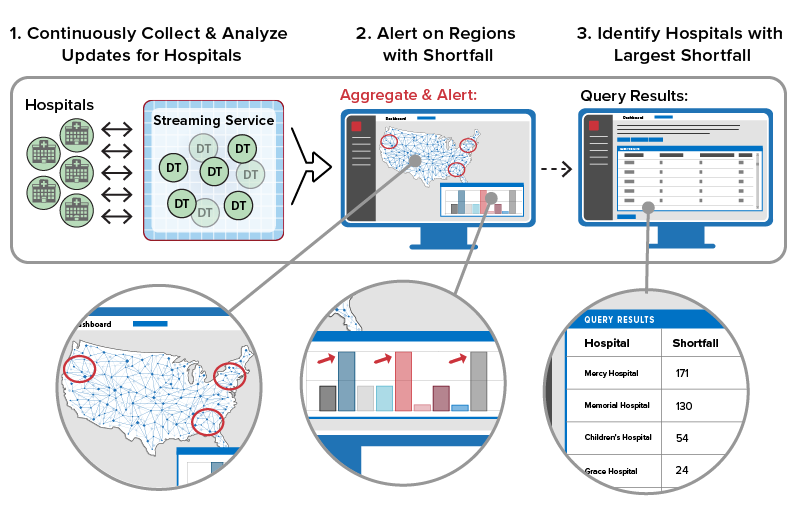Maintain and aggregate dynamic information for
thousands of data sources.
When analyzing telemetry from a large population of data sources, such as a fleet of rental cars or IoT devices in “smart cities” deployments, it’s difficult if not impossible for conventional streaming analytics platforms to track the behavior of each individual data source and derive actionable information in real time. Instead, most applications just sift through the telemetry for patterns that might indicate exceptional conditions and forward the bulk of incoming messages to a data lake for offline scrubbing with a big data tool such as Spark.
Maintain State Information for Each Data Source
An innovative new software technique called “real-time digital twins” leverages in-memory computing technology to turn the Lambda model for streaming analytics on its head and enable each data source to be independently tracked and responded to in real time. A real-time digital twin is a software object that encapsulates dynamic state information for each data source combined with application-specific code for processing incoming messages from that data source. This state information gives the code the context it needs to assess the incoming telemetry and generate useful feedback within 1-3 milliseconds.
For example, suppose an application analyzes heart rate, blood pressure, oxygen saturation, and other telemetry from thousands of people wearing smart watches or medical devices. By holding information about each user’s demographics, medical history, medications, detected anomalies, and current activity, real-time digital twins can intelligently assess this telemetry while updating their state information to further refine their feedback to each person. Beyond just helping real-time digital twins respond more effectively in the moment, maintaining context improves feedback over time.
Use State Information for Aggregate Analytics
State information held within real-time digital twins also provides a repository of significant data that can be analyzed in aggregate to spot important trends. With in-memory computing, aggregate analysis can be performed continuously every few seconds instead of waiting for offline analytics in a data lake. In this usage, relevant state information is computed for each data source and updated as telemetry flows in. It is then repeatedly extracted from all real-time digital twins and aggregated to highlight emerging patterns or issues that may need attention. This provides a powerful tool for maximizing overall situational awareness.
Consider an emergency monitoring system during the COVID-19 crisis that tracks the need for supplies across the nation’s 6,100+ hospitals and attempts to quickly respond when a critical shortage emerges. Let’s assume all hospitals send messages every few minutes to this system running in a central command center. These messages provide updates on various types and amounts of shortages (for example, of PPE, ventilators, and medicines) that the hospitals need to quickly rectify. Using state information, a real-time digital twin for each hospital can both track and evaluate these shortages as they evolve. It can look at key indicators, such as the relative importance of each supply type and the rate at which the shortages are increasing, to create a dynamic measure of urgency that the hospital receive attention from the command center. All of this data is continuously updated within the real-time digital twin as messages arrive to give personnel the latest status.
Aggregate analysis can then compare this data across all hospitals by region to identify which regions have the greatest immediate need and track how fast and where overall needs are evolving. Personnel can then query state information within the real-time digital twins to quickly determine which specific hospitals should receive supplies and what specific supplies should be immediately delivered to them. Using real-time digital twins, all of this can be accomplished in seconds or minutes.
This analysis flow is illustrated in the following diagram:

As this example shows, real-time digital twins provide both a real-time filter and aggregator of the data stream from each data source to create dynamic information that is continuously extracted for aggregate analysis. Real-time digital twins also track detailed information about the data source that can be queried to provide a complete understanding of evolving conditions and enable appropriate action.
Numerous Applications Need Real-Time Monitoring
This new paradigm for streaming analytics can be applied to numerous applications. For example, it can be used in security applications to assess and filter incoming telemetry (such as likely false positives) from intrusion sensors and create an overall likelihood of a genuine threat from a given location within a large physical or cyber system. Aggregate analysis combined with queries can quickly evaluate the overall threat profile, pinpoint the source(s), and track how the threat is changing over time. This information enables personnel to assess the strategic nature of the threat and take the most effective action.
Likewise, disaster-recovery applications can use real-time digital twins to track assets needed to respond to emergencies, such as hurricanes and forest fires. Fleets of rental cars or trucks can use real-time digital twins to track vehicles and quickly identify issues, such as lost drivers or breakdowns. IoT applications can use real-time digital twins to implement predictive analytics for mission-critical devices, such as medical refrigerators. The list goes on.
Summing Up: Do More in Real Time
Conventional streaming analytics only attempt to perform superficial analysis of aggregated data streams and defer the bulk of analysis to offline processing. Because of their ability to maintain dynamic, application-specific information about each data source, real-time digital twins offer breathtaking new capabilities to track thousands of data sources in real time, provide intelligent feedback, and combine this with immediate, highly focused aggregate analysis. By harnessing the scalable power of in-memory computing, real-time digital twins are poised to usher in a new era in streaming analytics.
We invite you to learn more about the ScaleOut Digital Twin Streaming Service™, which is available for evaluation and production use today.
